The bacon category, including refrigerated bacon and non-branded random weight bacon, recorded its highest dollar sales in five years for the 52 weeks ending July 15, according to Chicago-based IRI data of total U.S. multi-outlets. The entire bacon category posted $4.9 billion in sales, which was up from $4.7 billion for the same period the year before, IRI reports. Refrigerated and random weight bacons also are outpacing the total meat department, IRI reports.
“Bacon has been a total store superstar for the last two decades,” says Jonna Parker, principal of IRI Fresh.
On the other hand, volume sales of bacon are flat, and they are not as high as the all-time peak IRI recorded in 2015. Refrigerated bacon and non-branded random weight bacon saw volume sales of 900 million pounds for the 52 weeks ending July 15, IRI reports.
IRI also tracks that penetration of bacon is at 80 percent of U.S. households, compared with chicken at 93 percent. “The fact that bacon is not too far off of chicken is really important,” Parker says. “Bacon is really a powerhouse in the store right now.”
"I like to say that bacon [has] almost become one of the ultimate condiments, because it truly does make every food better."
The biggest contributor to bacon’s success this year is a higher average retail price per package.
“As we looked across geography and channels, bacon is commanding a higher price,” Parker says. “We also are seeing bacon promoted to consumers; however, it’s also at a higher retail price.”
Interestingly, IRI still tracks consumers purchasing bacon the same number of trips, but just buying slightly fewer pounds overall through the course of the year. “That’s why we are seeing flat pounds and up dollars,” Parker says. “Price is a big influence.”
Given bacon growing faster than the total meat department, the trends of pounds holding strong despite higher price paid and consumers still making just as many trips, IRI expects retailers will recognize they don’t need to discount bacon as much. “But we are certainly seeing a lot of retail fragmentation,” Parker says. “Bacon could become an item retailers might use to drive trips or support loyalty in their stores. All the trends on a macro basis show that bacon could keep growing and could certainly still upgrade in terms of price and qualities.”
Thick cuts grow
Pork bacon is 93 percent of total bacon sales, and Parker says is driving strong sales growth whereas turkey bacon is about 6 percent of sales. Turkey bacon is growing, but not as strong as pork bacon, she says.
“Bacon is very strong just on the back of its traditional positioning,” Parker says.
While traditional pork bacon regular cut is by far the most popular variety and still trending upward in sales, IRI reports that thick-cut bacon is growing in popularity, accounting for 23 percent of all bacon sales. Thick-cut bacon also is growing faster than the total category.
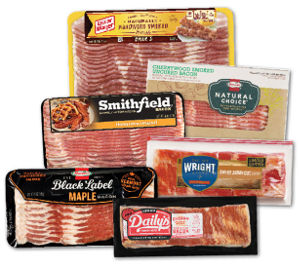
In addition, cooked bacon makes up only about 11 percent of total sales. A reason for uncooked bacon’s popularity could be that bacon is easy to prepare by different methods in its uncooked state unlike many other proteins, Parker says.
“It was interesting because I would’ve expected fully cooked bacon to be outperforming uncooked, because we’ve seen a general consumer trend toward convenience,” she explains. “Interestingly, in bacon, consumers actually preferred traditional bacon and traditional uncooked bacon is growing faster than cooked … It is an interesting category in that things we see in other parts of the store don’t apply in bacon. Consumers still really like traditional uncooked pork bacon, and, if anything, they want it thicker.”
Nick Schweitzer, senior brand manager of meat products for Hormel Foods Corp. in Austin, Minn., also sees thick cut rapidly growing in the category. “People want more indulgent products and better-tasting products, which you get a little bit better experience, in my opinion, from thick-cut bacon,” he explains.
Generally, thick-cut bacons are packaged in stack packs, which consumers associate with higher quality, more consistent bacon, and consumers are willing to pay for it, says Keith Arnold, Kansas City, Mo.-based Daily’s Premium Meats’ vice president of sales. “We’re finding thick cut bacon a major trend with consumers, who want to enjoy a premium experience, compared to what they would get with a commodity-style, lower-quality bacon,” he explains.
Traditionally, Daily’s has been a foodservice brand, and this summer Daily’s launched a line for retail to align with what consumers expect from thick-cut bacon: premium quality, flavorful and expertly crafted. Daily’s offers four varieties of the thick-cut stack pack bacon: Original, Applewood Smoked, Cherry Applewood Smoked and Black Pepper.
“Consumers continue to scrutinize ingredients,” Arnold says. “Consumers want bacon made with ingredients they know and understand.”
Arnold also sees pre-cooked bacon continuing to expand in the marketplace as cooking technology advances, allowing precooked bacon to have the taste and texture more like raw fresh-cooked bacon.
Bacon’s versatility
While IRI’s Parker would have thought the bacon category would have cooled slightly because bacon has been trendy for a few years now and is being put in everything, that is not the case. Bacon trends are a little different than some consumer trends, Parker says, but bacon speaks to consumers’ demand for indulgence and protein.
Hormel’s Schweitzer finds people have said the bacon craze was going to be a fad, but it continues to pick up speed. “I like to say that bacon [has] almost become one of the ultimate condiments, because it truly does make every food better,” he says. “It’s not just for breakfast anymore or a BLT. It’s all about wrapping shrimp or crumbling it up and using it as a topping for ice cream or seeing more bacon in Bloody Marys as stir sticks used across the country. It’s all about that occasion expansion, which is what’s driving sales for the bacon category.”
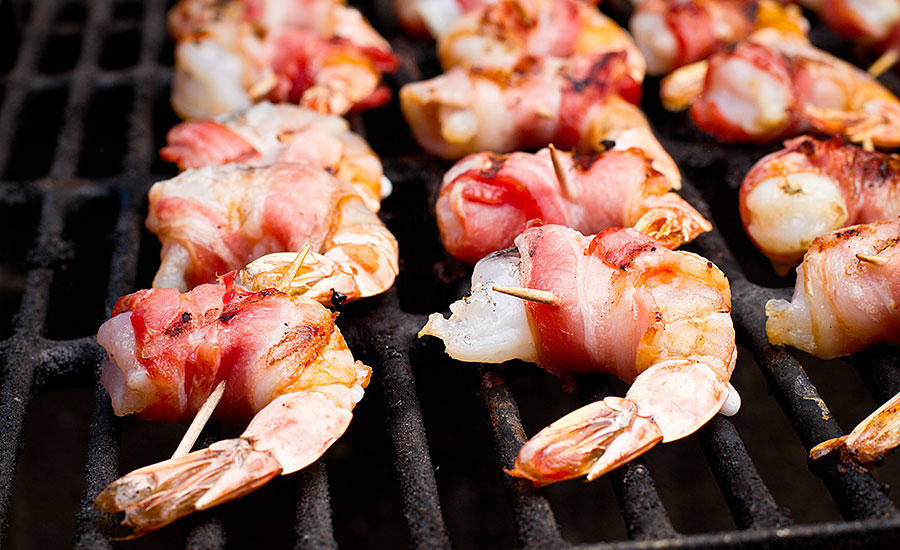
For the past couple of decades, bacon has been consistently consumed at about 3 percent of U.S. breakfasts a day, the NPD Group, in Port Washington, N.Y., reports. While that number seems small, it also has remained steady while other meat categories have shown declines to plant-based options or to chicken, which is less expensive, says Darren Seifer, food consumption industry analyst for The NPD Group.
Seifer also says bacon is an indulgent product. “It’s a great tasting product,” he says. “It’s more about how you feel after you consume it and if you have that sensation of tasting something really good. It’s helping flavor profiles of other meals you would find at restaurants and sometimes at home as well.”
While most bacon is still consumed at breakfast time, it continues to grow in other dayparts. With bacon’s versatility, consumers are finding new ways to use bacon and restaurants are preparing more dishes with bacon.
“Bacon is starting to show up as an ingredient in other dishes quite a bit,” Seifer says. “We see that also happening at dinnertime. We also see it happening at restaurants by the way of bacon burgers as well. What’s really going on for bacon right now is that they’re starting to find that it is very useful in many other types of food, and it could also help deliver a flavor profile that consumers like other than just at breakfast time.”
Consumer demands
One demand affecting the entire meat industry is consumers’ interest in knowing about what happens to the product before it hits the shelf, e.g., how animals were treated and what they were fed, the NPD Group’s Seifer says. For example, Smithfield leaned into the label transparency trend with a package refresh letting consumers know its bacon is gluten free, has no MSG or artificial colors or flavors and contains no added hormones.
"The demand for premium bacon will grow as consumers continue to look for delicious and indulgent offerings."
Consumers also have different preferences, which leads to different attributes in bacon. “For the health-conscious, they may prefer uncured and non-pork bacons,” says Vic DeMartino, director of marketing at Tyson Foods, in Chicago. “For the traditionalist, they want more hand-crafted, thick-cut bacon where the smoke profile is of utmost importance. We’re also noticing consumers want to include bacon in other dayparts outside of breakfast, so new flavors are becoming increasingly popular.”
In terms of flavor innovation, sweet and fruit flavorings, including sugar and cherry, are trending, but make up only about 5 percent of total sales, IRI reports.
For example, Tyson Foods’ Wright Brand Bacon does an annual flavor rotation. It started with a Barrel Aged Bourbon, then Oak Barrel Smoked, followed by Double Smoked, and most recently a launch in July of Sweet Barbecue. “These rotations continue to bring into the category new consumers by providing unique flavors for broader flavor pairings,” DeMartino says.
“We expect to see more regional brands pop onto the scene as consumers are very passionate about their bacon, as well as more craft bacons evolve from the backyard smokers to the grocery shelf,” he says. “The demand for premium bacon will grow as consumers continue to look for delicious and indulgent offerings.”
Production impact
The pork belly market continues to have an impact on bacon production, and consumer demand and usage drives the category, says Rikki Ingram, brand manager, Smithfield Breakfast, for Smithfield, Va.-based Smithfield Foods.
Keith Arnold, Kansas City, Mo.-based Daily’s Premium Meats’ vice president of sales, says the biggest challenges facing bacon this year have been the fluctuating belly prices from $0.85 to $1.75 a pound, as well as availability of smaller bellies because of larger hog weights, and cooking capacity within the industry.
From an economic standpoint, trade tariffs also have potential to affect pork prices and supply because of China’s and Mexico’s tariffs on U.S. pork products. “This could impact operators’ bottom lines and consumer consumption of bacon,” says Anne Mills, senior manager of consumer insights for Technomic, a Winsight Co., in Chicago. “… Right now, it remains to be seen how tariffs on pork will impact bacon supply and prices.”
With increasing demands for bacon production, Dold Foods, in Wichita, Kan. — the local manufacturing plant of Hormel Foods Corp. in Austin, Minn. — is growing with a 156,000-square-foot expansion, which is set to be completed this fall. The expansion will add more production lines for Hormel raw and fully cooked sliced bacon items produced at the facility.
“We’re excited about that in order to propel our growth into the future,” says Nick Schweitzer, senior brand manager of meat products for Hormel.
Different flavor options also drive growth for Hormel, such as its Applewood or Cherrywood Hormel Black Label Bacons, which are thick-cut products. “We’re seeing growth whether that being a traditional shingle package or a stack-pack package,” Schweitzer says.
Last year, Hormel launched Black Label Double Smoked Bacon, which highlights the smoke of the bacon to elevate its use in different occasions, and has delivered positive results for the company. “When you’re putting bacon on a burger, you want something that’s really smoky and to transfer that flavor to really power through that occasion,” Schweitzer explains.
Hormel’s newest products are Hormel Natural Choice Original Uncured Bacon and Hormel Natural Choice Cherrywood Smoked Uncured Bacon. The natural products offer a little bit better-for-you option for the category with a lower salt content while not compromising on flavor, Schweitzer says.
Shingle-pack bacon, such as Oscar Mayer Naturally Hardwood Smoked, remains Chicago-based Kraft Heinz Co.’s most popular, followed by varieties with thicker cuts of bacon, lower-sodium and unique flavors.
“As bacon’s popularity continues to grow, Oscar Mayer is proud to set the tone for what’s next as the leader in the bacon category, like our Oscar Mayer Natural Bacon,” says Matt Riezman, brand manager for Oscar Mayer. “Looking ahead, we know that consumers want a variety in choice and taste, and over the next couple of months, Oscar Mayer will introduce new flavors in both the raw and ready-to-serve bacon lines.”
Smithfield Foods, in Smithfield, Va., continues to see an increase in specialty recipes and smoke flavors, which deliver an authentic smokehouse taste, says Rikki Ingram, brand manager at Smithfield Breakfast. “Smithfield currently has a variety of smoke flavors, including Cherrywood and Applewood, which have risen to the top and are receiving strong year-over-year results,” he says.
In addition, this year the company launched a 22-ounce family pack to meet demands of consumers’ growing families.
Daily’s Arnold projects the bacon category will see new flavor combinations that allow the aroma and flavor of bacon to still shine through. “If done correctly, adding simple flavor additions, such as jalapeno, sriracha, sweetness and smoke, consumers can experience culinary exploration that pairs well with thick-cut premium bacon, while still keeping the nostalgia consumers often associate with bacon,” he says. “However, these flavor additions must be balanced so the bacon tastes and smells like consumers expect.”
In terms of health and wellness trends, natural overall is the most popular health claim in bacon, and about half of all dollar sales for bacon come from packages that include the word natural on their front. “Adding that all natural word to pack is something we see growing in bacon,” Parker says.

Beyond that, not many health claims are prevalent. IRI did track no hormone and antibiotic claims are trending upward, but only about 2 percent of bacons make either of those claims.
“Those are trending upward, which is consistent with things we see in other parts of the fresh meat department in packaging,” Parker says.
Specifically healthier bacon claims, such as reduced fat and lower sodium, are not growing. With the popularity of protein-rich diets currently, very few bacon packages tout a high protein or good source of protein claim either.
"Adding that all natural word to pack is something we see growing in bacon."
“[With] bacon being the original protein and a great source of protein, folks might think consumers just assume that, but that could be a potential opportunity,” Parker says.
IRI does expect continued strong sales for bacon. “We’ve seen five years of growth and that growth isn’t attributed to a short-lived trend or gimmick,” Parker says. “As long as bacon can continue to ensure its position in consumers’ minds as a tasty indulgence and/or a great source of protein, I definitely see bacon to continue a strong trajectory.” NP
Restaurants find new ways to menu bacon
In restaurants, bacon is on 71 percent of U.S. menus and featured in 3 percent of menu items, according to Datassential, in Chicago.
“Bacon is the fourth most-loved protein lagging behind only chicken, egg and beef,” says Claire Conaghan, Datassential’s syndicated group manager. “This makes it a consistent strong restaurant offering. Bacon’s ability to be paired with other proteins is a key advantage it has such as on chicken club sandwiches or bacon cheeseburgers.”
Despite such high penetration, it is still managing to grow. Datassential shows more than 4 percent more menus have bacon in 2018 than they did in 2014. Restaurants also continue to find new uses for bacon, with more than 6 percent more menu items featuring bacon in 2018 vs. 2014.
“Bacon menuing is growing across all dayparts with more restaurants offering bacon each year than the year prior,” Conaghan says. “Overall operators are finding new usages for bacon the most at lunch where the number of bacon items on menus is growing.”
In particular, sweet bacon varieties are growing, with maple bacon growing the fastest. Maple bacon increased 143 percent during the past four years and now is on 1 percent of menus, Datassential reports. Candied bacon is also growing rapidly, and up 88 percent during the past four years. It’s now on more than 1 percent of menus as well, the research firm says.
Technomic, a Winsight Co., in Chicago, shows among Top 500 and emerging U.S. chains, the number of operators offering menu items with bacon is stable from second quarter of 2017 to second quarter of 2018, but the number of menu items featuring bacon decreased 4.8 percent. The number of operators offering bacon as an add-on/topping increased 3.1 percent, though, and the number of add-on items/dishes featuring bacon increased 1.4 percent from second quarter of 2017 to second quarter of 2018, Technomic reports.
As far as innovation, bacon is being used as a touch of indulgence in trending grain bowls, Conaghan says. Overall bacon is not growing much in entrees, but she says usage across many other item types including nachos, atop other loaded options such as fries and in non-fried veggie apps and sides such as kale and Brussels sprouts dishes.
“More brunch places are offering bacon flights to highlight their different smoked and candied offerings, which is a unique usage as rarely is bacon the highlight of a dish, but this is a growing way to put bacon at center stage,” Conaghan adds.
While bacon is appearing as a topping on new burgers and sandwiches, Technomic also sees new ways of menuing bacon as part of the overall trend around innovation, says Anne Mills, Technomic’s senior manager, consumer insights. For example, Ruby Tuesday launched a new Southern-Inspired Menu recently and one of the new dishes is Bacon Deviled Eggs, featuring spicy deviled eggs with bacon and spices. Flipdaddys Burgers and Beers also launched a new menu, which features Bacon Candy, baked thick strips of cherrywood bacon coated with brown sugar and maple syrup, and sprinkled with Cajun seasoning.
Technomic also is seeing more poultry substitutes for bacon like turkey bacon on menus. In addition, the research firm is recording flavor innovations using brown sugar, which includes, but is not limited, to bacon. For example, Arby’s Bourbon BBQ Triple Stack and Chicken Bourbon BBQ Sandwiches both featured brown-sugar bacon. In July, Logan’s Roadhouse promoted Bacon on a Stick and a sirloin steak, a seasonal menu item featuring a half-pound of smoked bacon seasoned in a brown sugar glaze along with the steak.
Datassential is closely watching plant-based bacon options, which could be a challenge for traditional bacon if people want less animal protein or potential growth opportunity. A little bacon goes a long way, Conaghan says, and many plant-forward dishes already use bacon as an accent flavor.
From a menu perspective, Technomic expects to continue to see bacon menued in innovative ways as well as a focus on transparency of sourcing and preparation styles for bacon, e.g., applewood vs. cherrywood.
The NPD Group, in Port Washington, N.Y., expects the industry will see meats at the center of the plate flexing a little especially in restaurants, says Darren Seifer, food consumption industry analyst for the NPD Group. “I can see bacon continuing to increase mostly because of the flavor innovations that consumers are seeking these days,” he says. I talk to a lot of consumers, and bacon makes anything taste better. I think there’s this is real positive notion that bacon will enhance the flavor of anything.”


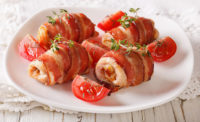
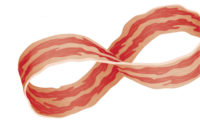
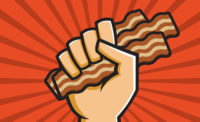
Report Abusive Comment